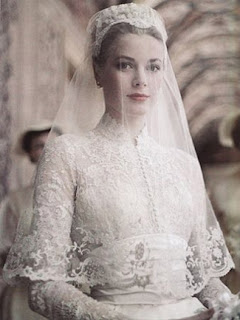During
the (wildly fun and busy) past month of weddings, were here at HJ noticed an increase
in the number of our brides wearing blushers. A blusher, for those of you dear
readers who are unfamiliar with them, is a piece of fabric that covers the
bride’s face as she walks down the aisle. The fabric is usually the same as
that of the veil, essentially making it a part of the veil – but a part that
can be either lifted back or detached, depending on its construction.
Interestingly,
the brides wearing blushers were our “older” brides. By older, we mean brides
in their mid- to late-30s, which we absolutely know is not old at all, but is
an identifier that allows for the following discussion. (Note: we fall within our
category of “older”. We hope to not have ruffled too much tulle by using the
term).
Why
is this “older” identifier interesting? Because blushers are, by far, extremely
traditional, and, yet, none of our “older” brides were traditional themselves. (Here,
we gracefully sidestep the younger/older bride personality comparison because
there really is no way to make one).
Way
way back in history, a blusher prevented marrying individuals from seeing one
another.
Traditionally,
because marriages were alliances made for political, security or financial
reasons, it mattered little to the arranging parties (i.e., the parents),
whether the bride and groom knew each other prior to their becoming betrothed or
married.
However,
blushers also prevented someone or something (meaning a group of someones),
from stopping the alliance. Brides wore veils so that nobody knew who she was,
thereby avoiding the possibility of her identity becoming known and a ruckus
(read: group of warriors barging into the church) ensuing. Protecting a bride’s
identity meant, in essence, protecting an alliance to which some may have
objected.
Consider
this: two sets of parents make an alliance between their children that will
cause, upon the parents’ deaths, the consolidation of the largest wealth from
one set and military force from the other in the area. Many local residents
might object to this consolidation since it can (and often did, making the fear
well-founded) lead to the two families overtaking and ruling the town.
The
thin piece of fabric that was a blusher, therefore, was a type of weapon.
Over
time, worries of clan warfare became less prevalent and those of spirits and
propriety more important. With this, the purpose of blushers changed to that of,
in the former situation, protecting the bride from evil spirits and, in the
latter, maintaining her reputation. In regards to reputation, the more people
who saw a woman, the less chaste and modest she was presumed to be – the cause
of why many women were “locked away” in castles or rooms.
When
all of these worries were wiped away sometime in the late 1800s, blushers became
a fashion statement. Today, they retain this status, as can be seen by their
varied opaqueness and length.
So,
why the increase in blushers lately? We attribute it to the
newly established style icon for women in their mid- to late-30s:
 |
| Lengthy blusher. |
 |
| Slice of netting = blusher. |
And to her sister:
 |
| Once again, netting = blusher. |
As
a side note: some claim that a blusher led to the bride’s being walked down the
aisle by her father. This is entirely false, since a woman was historically
never permitted to walk anywhere alone not only (once again) for propriety
sake, but also because there were no such people as “engineers” to create flat
surfaces – can you imagine falling down the aisle?
Finally,
I just can’t help myself from showing the gorgeousness that can be a blusher
via one of the most iconic brides of all time, Grace Kelly:

